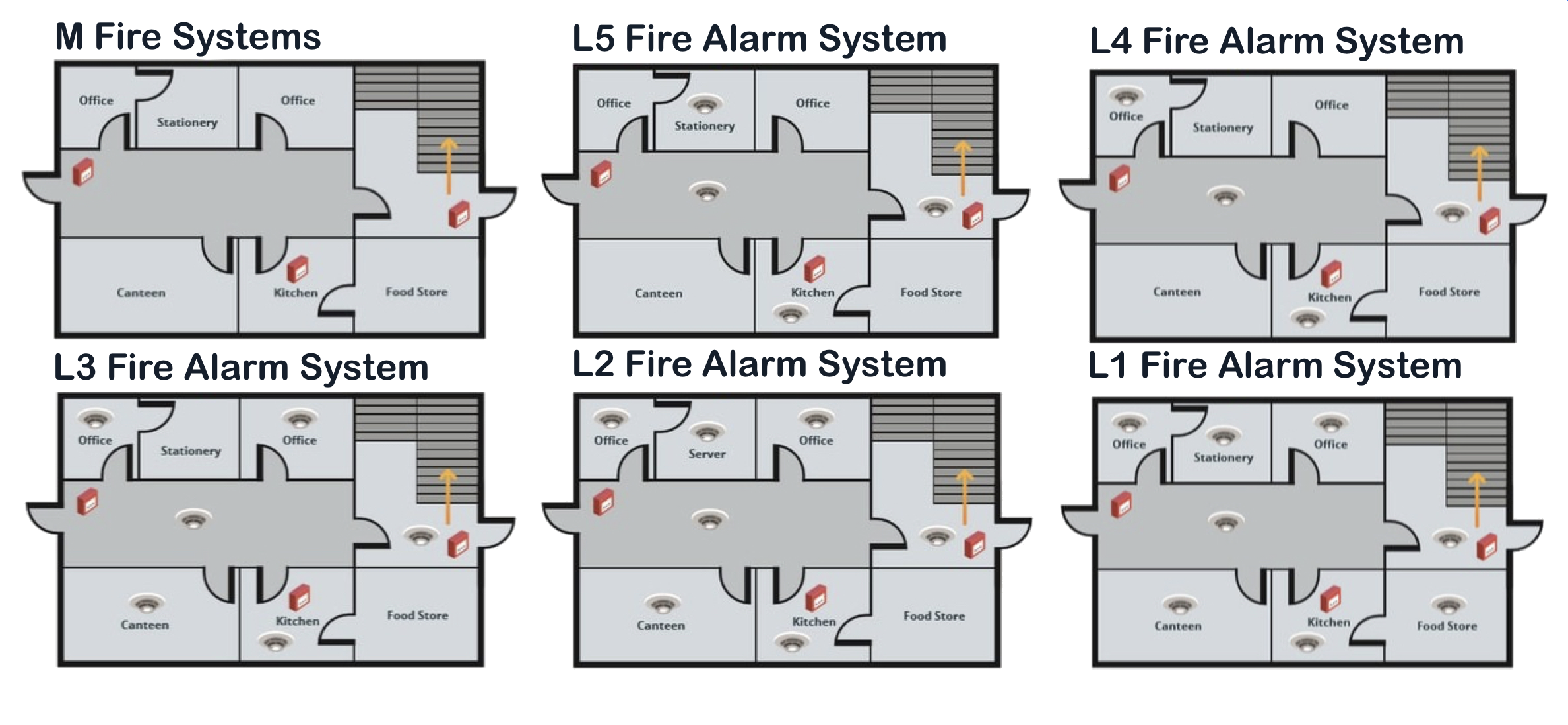Fire Alarm Categories
- Home
- Fire Alarm Categories
Fire Alarm Categories
The category of fire alarm system that you require can be found within the fire risk assessment carried out by a qualified and competent risk assessor. All categories differ and consist of the following :
Category M – Manual fire alarm system.
Category L1 – Maximum life protection automated fire alarm system.
Category L2 – Additional life protection automated fire alarm system.
Category L3 – Standard life protection automated fire alarm system.
Category L4 – Modest life protection automated fire alarm system.
Category L5 – Localised life protection automated fire alarm system.
Category P1 – Maximum property protection automated fire alarm system.
Category P2 – Minimum property protection automated fire alarm system.
Manual Fire Alarm Systems These are the least sophisticated of systems, which rely on the building’s occupants to detect a fire and provide a warning to others. When a fire is discovered, employees must activate the alarm manually, in order to alert everybody else in the building to the danger.
A typical example of a manual fire alarm system is a series of break glass units, which are installed at each point of exit in a building. This allows those escaping a fire to raise the alarm as they leave the danger zone.
Automatic Fire Alarm Systems For The Protection Of Life
Fire alarm systems that fall into the L category are those deemed most suitable for protecting life within a building. Systems designed for this purpose are divided into five sub-categories, depending on their level of effectiveness.

Category L1 – Maximum Life Protection
This is the most comprehensive fire alarm system, which features detectors in all areas of a building where a fire could feasibly start. Detectors are linked up to a centralised alarm system. This alerts the whole building should a fire break out. The objective of this setup is to ensure that inhabitants are given the earliest possible warning, should an emergency occur. It is therefore the ideal standard for premises such as large hotels and care homes, where early detection of a fire is crucial to the chances of escape. 

Category L2 – Additional Life Protection
Fire alarm systems that fall into this category feature smoke detectors in all rooms that form part of an escape route, including corridors. Detectors also need to be installed in all high-risk rooms, such as kitchens, boiler rooms and areas with heavy plant machinery.
L2 systems are effective at providing an early warning to occupants beyond the source of the fire and those working in high risk areas. Examples of properties that typically employ this system include factories or medium sized residential premises. 

Category L3 – Standard Life Protection
Standard life protection systems feature detectors in all escape routes and rooms that open onto an escape route. The objective of this system is to ensure that all inhabitants of the building are given enough warning to escape a fire, before their exit is impeded by the presence of flames, smoke or toxic fumes.
This category of fire alarm system is typically adopted in regular sized office blocks and commercial buildings that have flights of stairs. 

Category L4 – Modest Life Protection
An L4 category fire alarm system consists of detectors within escape route areas only, such as in corridors and stairways. Any circulation areas that makes up part of the escape passage should also be fitted with a detector.
Commercial properties that generally adopt this category of system are those that have a lower level of risk. For example, an office that consists of ground floor rooms only would require less warning time to evacuate all personnel. 

Category L5 – Localised Life Protection
L5 fire alarm systems are those that are installed to tackle a specific fire risk in a certain area of a building. For example, if there is a room in a building that poses an exceptional hazard because of the items stored there or business activities carried out there.
An L4 category system may be appropriate for the building in general but an L5 system is also required, in order to recognise the level of risk this particular room presents.

Automatic Fire Alarm Systems For The Protection Of Property
P category fire alarm systems are those that are designed to protect property. It is appropriate to label a system under this category, when considering how a business and its operations will be protected from the risk of fire. 

Category P1
A P1 fire alarm system involves installing detectors in all areas of the building. The objective of a system like this is to protect buildings that are critical to the operations of a business.
By implementing maximum protection across a whole site, those in charge of fire safety can ensure that any fire that breaks out is detected and neutralised as quickly as possible. This lowers the risk of damage and disruption and in turn, the financial impact that a fire could inflict on a company. 

Category P2
In a category P2 fire alarm system, fire detectors are installed in high risk areas only. Whilst a system like this does not provide the same level of cover as a P1 solution, it does provide early detection for the most likely sources of a fire.
Help And Support
We are able to assist with advice on which category you may require within your building or premises, click here to contact our risk assessment team.
You can trust our service and experience.
Fire Alarm Systems For All Types Of Businesses :
- Office Blocks
- Commercial Units
- Schools
- Retail
- Hospitals
- Industrial Warehouses
- Flats & Apartment Blocks

Contact Us Today
Click Here To Contact Our Risk Assessment Team
Want To Discuss your Fire Alarm Installation requirements in more detail?
Complete our online enquiry or call our team on 0330 055 2228
Interested in Business Security, Fire Alarm Systems, Fire Protection Services, Access Control, CCTV Systems, Intruder Alarms or Electrical Installation?


